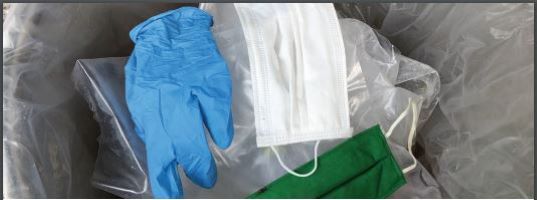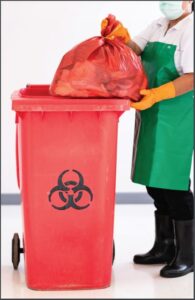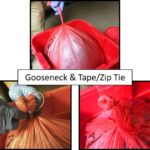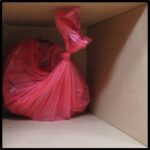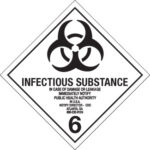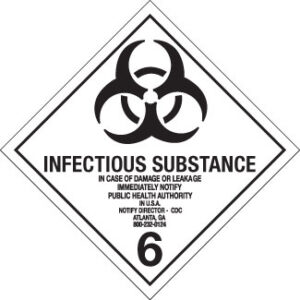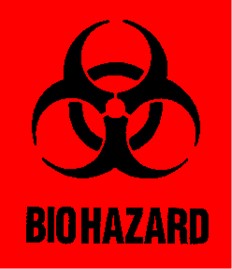The COVID-19 public health emergency within the U.S. has created an unprecedented challenge for EHS professionals. One challenge: what to do with the waste generated during the testing for the coronavirus and the treatment of those with COVID-19? An earlier article (FAQ: Are wastes associated with COVID-19 a hazardous waste?) explained the status of this waste under Federal regulations of the USEPA and state regulations – primarily for its on-site management.
This article will address the regulatory requirements of the U.S. Environmental Protection Agency (USEPA), state environmental regulatory agencies, and the Pipeline and Hazardous Materials Safety Administration within the U.S. Department of Transportation (USDOT/PHMSA) for the off-site transportation of waste contaminated – or potentially contaminated – with SARS-CoV-2 (the virus that causes COVID-19).
Before we begin…
- For the purposes of this article, a waste potentially contaminated with a pathogen or infectious agent (e.g., SARS-CoV-2), will be referred to as a Regulated Medical Waste. As will be seen later, state regulations may vary in the name they use for this waste.
- Though written during the COVID-19 public health emergency, and directed toward the waste generated by it, the information in this article is applicable to any waste potentially contaminated with a pathogen or infectious agent.
Scope and Applicability:
This information solely applies to the generation of waste and its transportation within the United States.
The Players:
- U.S. Environmental Protection Agency (USEPA) – along with other environmental responsibilities, enforces the regulations created by the Resource Conservation and Recovery Act (RCRA) for the cradle-to-grave management of all waste.
- State environmental agencies – a state with RCRA authorization will manage its own hazardous waste program with its own state-specific regulations. Even states lacking RCRA authorization will have regulations unique to their state for the management of Regulated Medical Waste.
- The Pipeline and Hazardous Materials Safety Administration within the U.S. Department of Transportation (USDOT/PHMSA) – regulates the transportation of hazardous materials within the U.S.
- The Center of Disease Control and Prevention (CDC) – is the leading national public health institute of the United States.
- The Occupational Health and Safety Administration – ensures safe and healthful working conditions for working men and women by setting and enforcing standards and by providing training, outreach, education and assistance.
|
Like this article? Subscribe to my Monthly Newsletter No marketing emails! |
What is the source of the Regulated Medical Waste?
- Household – A Regulated Medical Waste generated by or in a household will not be subject to Federal regulations of either USEPA or USDOT/PHMSA. And, it is very unlikely – but possible – that a state will regulate the waste generated in a household, even a Regulated Medical Waste. A household that generates a Regulated Medical Waste should follow CDC guidelines and not bother reading the remainder of this article.
- Healthcare – A Regulated Medical Waste generated by healthcare providers, medical facilities, hospitals, community-based testing sites, or other commercial or government facilities – in short: any source other than a household – will be subject to some USEPA regulations, stringent state regulations, and USDOT/PHMSA regulations. Those person should continue reading this article.
- Industrial / Commercial / Public Facility Not Associated with Healthcare – That’s a bit more difficult. As will be described in more detail in this article, Federal regulations do not indicate a source for Regulated Medical Waste. State regulations with which I am familiar, limit the source of Regulated Medical Waste to healthcare, tattoo parlors, veterinary, and other similar where needles come in contact with human or animal tissue. Here is the definition of Potentially Infectious Medical Waste by the Illinois EPA:
Potentially Infectious Medical Waste (PIMW) is waste generated in connection with:
- The diagnosis, treatment (i.e., provision of medical services), or immunization of human beings or animals;
- Research pertaining to the provision of medical services; or
- The production or testing of biological waste.
And…
PIMW does NOT include:
- Medical waste generated as general household waste;
- PIMW (except for sharps) which has been treated properly to eliminate its infectious nature; and
- Sharps which have been treated to eliminate their infectious nature and which have been rendered unrecognizable by treatment.
While that definition (check with your state) does specifically exclude a “medical waste” generated in a household, it does not specifically include nor exclude a Regulated Medical Waste generated in a industrial/commercial/or other public non-healthcare source. However, if the facility has a nurse or first aid station or has collection containers for medical waste (e.g., sharps); that might meet the criteria for “provision of medical services” and therefore be subject to regulation.
So, what is a non-healthcare related facility to do? I suggest any waste that could be reasonably expected to contain a pathogen be treated as a Regulated Medical Waste per the regulations of your state and USDOT/PHMSA. As a practical matter I would not include band-aids and other miscellaneous as Regulated Medical Waste. Hypodermic needles – used or unused – are an automatic.
Is the Regulated Medical Waste a hazardous waste?
In an earlier article I conducted a hazardous waste determination for wastes associated with COVID-19, the result of which is: Regulated Medical Waste exposed – or presumed to be exposed – to SARS-CoV-2 will not be a hazardous waste by either USEPA or state regulations.
(From USEPA website) Q: Does RCRA regulate wastes that may contain the virus that causes COVID-19, such as used medical equipment or personal protective equipment?
A: RCRA regulations do not define wastes as hazardous due to their infectious nature, including those contaminated by the novel coronavirus which causes COVID-19.
Q: If not a hazardous waste per Federal or state regulations, does that mean my Regulated Medical Waste is not subject to any regulation at all?!?
A: No. USEPA delegates the cradle-to-grave management of a non-hazardous waste to each state – regardless of whether or not it has RCRA authorization. States, then determine the requirements for management of Regulated Medical Waste in their state.
|
Note: EPA has not had authority to manage Regulated Medical Waste since the Medical Waste Tracking Act (MWTA) of 1988 expired in 1991. |
In what state is the Regulated Medical Waste generated?
If you have determined that your Regulated Medical Waste is not a hazardous waste per USEPA or state regulations, your next step is to determine the regulations of your state for its cradle-to-grave management as a Regulated Medical Waste (or whatever name your state uses). This website is a good place to begin to identify, research, and comply with the regulations of your state for the management of Regulated Medical Waste.
Regulations of USDOT/PHMSA for Off-Site Transportation of Regulated Medical Waste:
Regardless of USEPA’s Federal regulations and those of your state, USDOT/PHMSA regulates the transportation in commerce of all hazardous materials (HazMat); included in the definition of hazardous materials are wastes contaminated with SARS-CoV-2. Therefore, in addition to any regulations of your state, you must also comply with the Hazardous Materials Regulations (HMR) of USDOT/PHMSA if the waste will be transported off-site for disposal. A waste contaminated with SARS-CoV-2 will be classified as a HazMat per the HMR as follows.
An entry for waste contaminated with SARS-CoV-2 is found in column 2 of the Hazardous Materials Table at 49 CFR 172.101:
Regulated medical waste, n.o.s. or Clinical waste, unspecified, n.o.s. or (BIO) Medical waste, n.o.s., or Biomedical waste, n.o.s. or Medical waste, n.o.s
Each of the names above displayed in bold print separated by an “or” is an acceptable proper shipping name. For the purposes of this article, I will continue to use Regulated Medical Waste.
Column 3 of the Hazardous Materials Table for this entry indicates it is a Division 6.2 Infectious Substance. §173.134(a)(1) of the HMR defines a Division 6.2 Infectious Substance as a material known or reasonably expected to contain a pathogen. (SARS-CoV-2 is a pathogen.) Also, an Infectious Substance must be assigned to either Category A (in a form capable of causing permanent disability or life-threatening or fatal disease in an otherwise healthy human if exposed) or Category B (a pathogen that is not Category A). From the USEPA website of COVID-19 FAQs:
OSHA and CDC do not consider the COVID-19 virus as a DOT Category A Infectious Substance.
And this directly from the CDC website:
Pack and ship suspected and confirmed SARS-CoV-2 patient specimens, cultures, or isolates as UN 3373 Biological Substance, Category B…
Also, §173.134(a)(5) defines a Regulated Medical Waste:
Regulated medical waste or clinical waste or (bio) medical waste means a waste or reusable material derived from the medical treatment of an animal or human, which includes diagnosis and immunization, or from biomedical research, which includes the production and testing of biological products. Regulated medical waste or clinical waste or (bio) medical waste containing a Category A infectious substance must be classed as an infectious substance, and assigned to UN2814 or UN2900, as appropriate.
Therefore, a waste contaminated – or suspected of being contaminated – with SARS-CoV-2 will be classified by USDOT/PHMSA as follows:
- UN3291, Regulated medical waste, n.o.s., Division 6.2, Packing Group II. And also a Category B Infectious Substance.
|
Contact me with any questions you may have about the generation, identification, management, and disposal of waste Daniels Training Services, Inc. 815.821.1550 |
There are two broad options for the packaging and off-site transportation of a Regulated Medical Waste of Category B:
- Package and ship as a fully-regulated HazMat per packing instructions of §173.197.
- Package and ship per the packaging exception of §173.134(c).
Note: What follows is a summary of the complete regulations and will exclude those regulations not applicable to COVID-19 waste. If you intend to package and ship a Regulated Medical Waste you must conduct further research into these regulations.
Packaging for Regulated Medical Waste §173.197:
- Each of the following are authorized packagings:
- Non-bulk packagings
- Large Packagings
- Non-specification bulk outer packagings
- Any authorized packaging must be a rigid container and must meet the general packing requirements of §173, subpart B.
- Non-bulk packagings:
- Must be a UN standard packaging per the requirement of Part 178 at the Packing Group II performance level.
- A sharps container must be puncture-resistant per Part 178 and securely closed.
- Large Packagings:
- Must be constructed, tested, and marked per the requirements of Part 178, subparts P and Q for a Large Packaging.
- Regulated Medical Waste must be contained in inner packagings that meet the requirements of §173.197(e) (summarized below).
- Inner packagings used for liquids must be rigid.
- The Large Packaging is subject to testing, design qualification, and recordkeeping requirements of intermediate bulk containers (IBCs) in §178, subpart O.
- Authorized Large Packagings are limited to the following:
- Metal: 50A, 50B, or 50N
- Rigid plastic: 50H
- A Large Packaging containing liquid Regulated Medical Waste must contain enough absorbent material to absorb the entire amount of liquid.
- A Large Packaging for sharps containers must be puncture resistant and capable of retaining liquids and must meet the performance tests for an IBC intended for liquids at §178, subpart O.
|
If you like this article, please share it using any of the social media platforms identified at the bottom of this article. |
- Non-specification bulk packaging:
- Authorized non-specification bulk packagings are a wheeled cart (Cart) or bulk outer packaging (BOP).
- Regulated Medical Waste in each Cart or BOP must be in non-bulk inner packagings in conformance with §173.197(e) (more on this later).
- Each Cart or BOP must have smooth, non-porous interior surfaces that are free of cracks, crevices, and other defects that could damage plastic film inner packagings or impede disinfection operations.
- Each Cart of BOP must be used exclusively for the transportation of Regulated Medical Waste.
- Before reuse, each Cart or BOP must be disinfected by any means effective for neutralizing the infectious substance it previously held.
- Untreated concentrated stock cultures of Category A infectious substances may not be transported in a Cart or BOP.
- Division 6.1 Poisonous (Toxic) Material and Class 7 Radioactive may not be transported in a Cart or BOP unless a chemotherapeutic waste.
- The following may be transported in a Cart or BOP only if contained within a rigid non-bulk packaging:
- Division 6.1 Poisonous (Toxic) Materials or Class 7 Radioactive chemotherapeutic waste.
- Untreated concentrated stock cultures containing Category B infectious substances.
- Unabsorbed liquids.
- Sharps
- Per §173.197(d)(2) a Cart must also conform to the following requirements:
- Each Cart must consist of a solid, one-piece body with a capacity of 1,655 L (437 gallons) or less.
- Each cart must be constructed of metal, rigid plastic, or fiberglass and fitted with a lid to prevent leakage.
- Each Cart must be capable of meeting the requirements of the drop test for an IBC at the Packing Group II performance level as required by §178.810.
- Inner packagings must be restrained within the Cart to minimize the risk of breakage.
- Per §173.197(d)(3) a BOP must also conform to the following requirements:
- Each BOP must be constructed of metal or fiberglass.
- Each BOP must have a capacity of at least 3.5 cubic meters (123.6 cubic feet) and not more than 45 cubic meters (1,590 cubic feet).
- Each BOP must have bottom and side joints of fully welded or seamless construction and a rigid, weatherproof top to prevent the intrusion of water.
- Each opening in a BOP must be fitted with a closure to prevent the intrusion of water or the release of any liquid.
- While upright and with closures open, each BOP must be leakproof and able to contain at least 300 liters (79.2 gallons) of liquid.
- Inner packagings must be placed in a BOP in a manner to minimize the risk of breakage.
- Rigid inner packagings may not be placed in the same BOP with plastic film bag inner packagings unless separated from each other by rigid barriers or dividers.
- Inner packagings of the following may be transported in a BOP only if separated from each other by rigid barriers or dividers:
- Division 6.1 Poisonous (Toxic) Materials or Class 7 Radioactive chemotherapeutic waste.
- Untreated concentrated stock cultures containing Category B infectious substances.
- Unabsorbed liquids.
- Sharps
- Inner Packagings for Large Packagings, Carts, and BOPs per §173.197(e):
- Inner packagings must be durably marked with the name and location (city and state) of the entity that offered the Regulated Medical Waste for transportation (i.e., the shipper) unless it originated at a single location and is delivered to a single location.
- A plastic film bag is authorized as an inner packaging for solid Regulated Medical Waste.
- A plastic film bag is authorized as an inner packaging for an absorbed liquid if the bag contains sufficient absorbent for all liquid.
- The plastic film bag may not exceed a volume of 175 L (46 gallons).
- The plastic film bag must be marked and certified by its manufacturer as having passed specific tear resistance and impact resistance testing (refer to §173.197(e)(1)(i)).
- The plastic film bag must closed with a minimum of entrapped air to prevent leakage during transportation.
- The plastic film bag must be capable of being held upside down with the closed end at the bottom for a period of five (5) minutes without leakage.
- A plastic film bag may not have a gross package weight of more than 10 kg (22 lbs) when filled.
- Single knot
-
- Liquid Regulated Medical Waste inner packagings must be rigid and conform to the general packing requirements of §173, subpart B.
- An inner packaging for a liquid may not have a capacity of more than 19 L (5 gallons).
- Sharps must be packaged in puncture-resistant inner packagings, securely closed, and not exceed a capacity of 76 L (20 gallons) unless able to pass specified performance tests.
- A sharps container may be reused only if it conforms to the following criteria:
- It is specifically approved and certified by the U.S. Food and Drug Administration as a medical device for reuse.
- It is permanently marked for reuse.
- It is disinfected prior to reuse by any means effective fofor the infectious substance it last held.
- It must have a volume capacity of more than 7.57 L (2 gallons) and not exceed 151.42 L (40 gallons).
Packaging Exception for Regulated Medical Waste at §173.134(c):
An exception from the packaging requirements of §173.197 is available at §173.134(c) and summarized below.
A Regulated Medical Waste may display the “BIOHAZARD” marking per OSHA regulations at 29 CFR 1910.1030 instead of the Division 6.2 Infectious Substance label if its transportation is by a private carrier or contract carrier.
- USDOT Division 6.2 Label
- OSHA BioHazard Symbol
Further, a Regulated Medical Waste is not subject to the packaging requirements of §173.197, if it complies with the following:
- Its transportation is by a private or contract carrier.
- It is packaged in a rigid non-bulk packaging.
- The packaging conforms to the general packing requirements of §173.24 and §173.24a.
- The packaging also conforms to the packaging requirements of OSHA’s Bloodborne Pathogen regulations at 29 CFR 1910.1030. This isn’t that different than the USDOT/PHMSA packaging requirements: leakproof, puncture-resistant, color-coded (red) or labeled, closeable and closed before transport.
- It does not contain a waste concentrated stock culture of an infectious substance.
If the Regulated Medical Waste complies with all of the above and is transported in a vehicle used exclusively to transport Regulated Medical Waste (as explained in this letter of interpretation: LOI 07-0057, “An exclusive-use vehicle is one used for the transportation of a single commodity or class of commodities;”) The following may then be transported as a Regulated Medical Waste under this exception:
- Waste stock or culture of a Category B infectious substance.
- Plant and animal waste regulated by the Animal and Plant Health Inspection Service (APHIS).
- Waste pharmaceutical materials.
- Laboratory and recyclable wastes.
- Infectious substances that have been treated to eliminate or neutralize pathogens.
- Forensic materials being transported for final destruction.
- Rejected or recalled health care products.
- Documents intended for destruction in accordance with the Health Insurance Portability and Accountability Act of 1996 (HIPAA) requirements.
- Medical or clinical equipment and laboratory products provided they are properly packaged and secured against exposure or contamination.
- And one more: Sharps in sharp containers provided the containers are securely closed to prevent leaks or punctures; do not exceed 18 gallons capacity; registered under the Medical Device Regulations of FDA; made of puncture resistant plastic that meets ASTM Standard F2132-01, Standard Specification for Puncture Resistance of Materials Used in Containers for Discarded Medical Needles and Other Sharps; and are securely fitted into wheeled racks that hold them in an upright position. The wheeled racks must contain full rows of sharps containers secured in place by a moveable bar; and must be securely held in place on the motor vehicle by straps or load bars during transportation. No shelf in any wheeled rack may exceed the manufacturer’s recommended load capacity.
|
Daniels Training Services, Inc. 815.821.1550 |
What about other requirements of the HMR for Regulated Medical Waste?
Regardless of whether it is transported in compliance with §173.197 or §173.134(c), all other requirements for the transportation of HazMat remain. These include:
- Package marks and labels:
- UN/ID number: UN3291
- Proper shipping name: Regulated medical waste, n.o.s.
- Division 6.2 Infectious Substance label or “BIOHAZARD” marking.
- Name and address of shipper or receiver.
- DOT specification (UN standard) mark if to be transported in a non-bulk packaging or a large packaging according to §173.197.
- Since there is no placard for Division 6.2 Infectious Substance, display of placards on a vehicle or freight container is not required. However, if Regulated Medical Waste is packed in a bulk packaging and the BIOHAZARD marking on the bulk packaging is not visible, the transport vehicle or freight container must be marked with the BIOHAZARD marking on each side and each end, in accordance with 49 CFR 172.323.
- UN/ID number and proper shipping name
- USDOT Division 6.2 Label
- OSHA BioHazard Symbol
- Shipping papers which include the following:
-
- Basic description of HazMat in proper sequence: UN3291, Regulated medical waste, n.o.s., Division 6.2, PG II
- Total quantity.
- Number and type of packaging.
- Emergency response information: ERG 158
- Emergency response telephone.
- Shipper’s certification.
- HazMat Employee training for any person involved in the off-site transportation of a Regulated Medical Waste.
This PowerPoint presentation created by USDOT/PHMSA summarizes the requirements of §173.134(c) and includes some common industry practices for closure of inner packagings and bags of Regulated Medical Waste.
One More Option for the Transportation of Regulated Medical Waste:
A Regulated Medical Waste is eligible for the Materials of Trade exception at §173.6.
|
If you like this article, please share it using any of the social media platforms identified at the bottom of this article. |
More FAQs About COVID-19 Waste:
(From the CDC website) Q: Should medical waste or general waste from healthcare facilities treating PUIs (patient under investigation) and patients with confirmed COVID-19 be handled any differently or need any additional disinfection?
A: Medical waste (trash) coming from healthcare facilities treating COVID-2019 patients is no different than waste coming from facilities without COVID-19 patients. CDC’s guidance states that management of laundry, food service utensils, and medical waste should be performed in accordance with routine procedures. There is no evidence to suggest that facility waste needs any additional disinfection.
More guidance about environmental infection control is available in section 7 of CDC’s Interim Infection Prevention and Control Recommendations for Patients with Confirmed COVID-19 or Persons Under Investigation for COVID-19 in Healthcare Settings.
(From USEPA website) Q: What requirements would apply to export or import of wastes associated with the novel Coronavirus or Coronavirus Disease 2019 (COVID-19)?
A: At present, there are no U.S. federal export or import requirements under the Resource Conservation and Recovery Act (RCRA) regulations for the transboundary shipment of medical waste or infectious waste. The hazardous waste regulations under RCRA do not define wastes as hazardous due to their infectious nature, including wastes contaminated with the COVID-19 virus. But export or import shipments of such waste would be subject to the laws and regulations of the other country sending or receiving the shipments, any countries the shipments would go through, and any applicable international agreements.
Under the Basel Convention on the Control of Transboundary Movements of Hazardous Wastes and their Disposal (“Basel Convention”), the Basel hazardous waste A4020 listing (“Clinical and related wastes; that is wastes arising from medical, nursing, dental, veterinary, or similar practices, and wastes generated in hospitals or other facilities during the investigation or treatment of patients, or research projects”) may apply to transboundary shipments of such medical wastes. Information on the import requirements, export requirements and competent authority contacts for specific countries are available at the Export and Import Control Tool.
Finally, if the waste being shipped is controlled as hazardous by only one of the countries of export and import, then the notice and consent procedures and other associated procedures are administered by the country that controls the waste as hazardous. This is referenced in Title 40 of the Code of Federal Regulations section 262.82(a)(2)(ii). Please note that while the Centers for Disease Control and the Occupational Safety and Health Administration do not consider wastes associated with coronavirus or COVID-19 to be U.S. Department of Transportation Category A Infectious Substances, other countries may categorize these wastes as a Category A Infectious Substance, therefore in such cases transboundary shipments would need to comply with those countries’ requirements related to Category A infectious substances.
For more information:
|
Contact me with any questions you may have about the transportation of hazardous materials by air, highway, vessel, or rail International and Domestic Daniels Training Services, Inc. 815.821.1550 |
Conclusion:
If done in compliance with the regulations – and with some common sense – a Regulated Medical Waste – even one contaminated with the virus that causes COVID-19 – may be managed on-site, prepared for off-site transportation, and transported to final disposal safely. Please be safe and please contact me if you have any questions about the management of waste or the transportation of hazardous materials.
